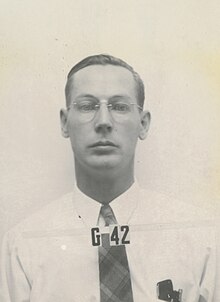
Back دونالد وليام كيرست Arabic دونالد ویلیام کرست AZB Donald William Kerst German Donald William Kerst Basque دونالد ویلیام کرست Persian Donald William Kerst French Donald William Kerst Italian Donald William Kerst NN Donald William Kerst Portuguese Керст, Дональд Вильям Russian
Donald W. Kerst | |
|---|---|
 Kerst's Los Alamos badge | |
| Born | Donald William Kerst November 1, 1911 Galena, Illinois, U.S. |
| Died | August 19, 1993 (aged 81) Madison, Wisconsin, U.S. |
| Nationality | American |
| Alma mater | University of Wisconsin–Madison (BA 1934, PhD 1937) |
| Known for | Betatron |
| Awards | Comstock Prize in Physics (1943) |
| Scientific career | |
| Fields | Physics (Accelerator physics, Plasma physics) |
| Institutions | University of Illinois Los Alamos Laboratory University of Wisconsin |
| Thesis | The Development of Electrostatic Generators in Air Pressure and Applications to Excitation Functions of Nuclear Reactions (1937) |
Donald William Kerst (November 1, 1911 – August 19, 1993) was an American physicist who worked on advanced particle accelerator concepts (accelerator physics) and plasma physics. He is most notable for his development of the betatron, a novel type of particle accelerator used to accelerate electrons.
A graduate of the University of Wisconsin, Kerst developed the first betatron at the University of Illinois at Urbana Champaign, where it became operational on July 15, 1940. During World War II, Kerst took a leave of absence in 1940 and 1941 to work on it with the engineering staff at General Electric, and he designed a portable betatron for inspecting dud bombs. In 1943 he joined the Manhattan Project's Los Alamos Laboratory, where he was responsible for designing and building the Water Boiler, a nuclear reactor intended to serve as a laboratory instrument.
From 1953 to 1957 Kerst was technical director of the Midwestern Universities Research Association, where he worked on advanced particle accelerator concepts, most notably the FFAG accelerator. He was then employed at General Atomics's John Jay Hopkins Laboratory from 1957 to 1962, where he worked on the problem of plasma physics. With Tihiro Ohkawa he invented toroidal devices for containing the plasma with magnetic fields. Their devices were the first to contain plasma without the instabilities that had plagued previous designs, and the first to contain plasma for lifetimes exceeding the Bohm diffusion limit.
© MMXXIII Rich X Search. We shall prevail. All rights reserved. Rich X Search